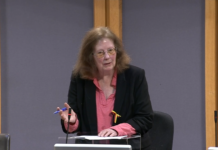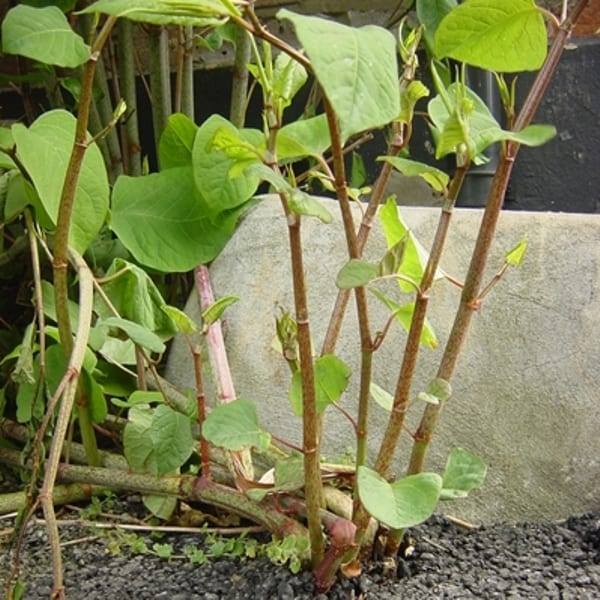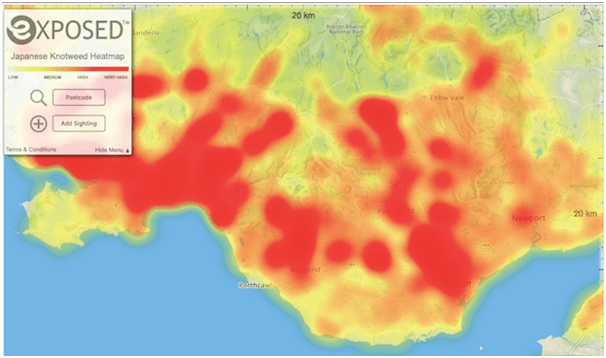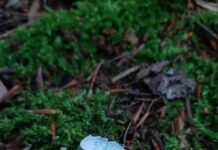Capel Garmon, Conwy, tops list as location worst affected by UK’s most invasive plant
02 July 2019: The top ten Japanese knotweed hotspots in Wales have been revealed today by Environet UK. Carpel Garmon in Conwyis the worst affected locationwith395 infestations within a 4km radius,followed by Llanelli in Carmarthanshire, Caerphilly and Swansea.
Described by the Environment Agency as “indisputably the UK’s most aggressive, destructive and invasive plant”, Japanese knotweed grows rampantly along railways, waterways, in parks and gardens and is notoriously difficult to treat without professional help.
Environet has mined data from its online heatmapExposed: The Japanese Knotweed Heatmap, launched earlier this year, which records Japanese knotweed sightingsacross the UK. The map is intended to inform local homeowners and potential homebuyers of the local presence of Japanese knotweed, enabling them to enter a postcode to discover the number of reported knotweed sightings nearby, with hotspots clearly visible in yellow or red.
Table 1: Top ten Japanese knotweed hotspots in Wales
| No. | Location | No. of infestations within 4km |
| 1 | Capel Garmon, Conwy | 395 |
| 2 | Llanelli, Carmarthanshire | 380 |
| =3 | Caerphilly | 326 |
| =3 | Swansea | 326 |
| 5 | Bridgend | 249 |
| 6 | Aberystwyth, Ceredigion | 220 |
| 7 | Bala, Gwynedd | 220 |
| 8 | Pembrokeshire National Park | 106 |
| 9 | Newtown, Powys | 80 |
| 10 | Holyhed, Gwynned | 54 |
Japanese knotweed can deter buyers, making a property difficult to sell and prevent a mortgage lender approving a loan unless a treatment plan is in place with an insurance-backed guarantee, thereby impacting a property’s value by around 10%.Sellers are required by law to inform potential purchasers whether their home is, or has been, affected by Japanese knotweed, which can act as a deterrent even if the infestation has been treated.
Environet estimates that Japanese knotweed currently affects 4 to 5% of UK properties, wiping a total of £20 billion off house prices.
Nic Seal, Founder and MD of Environet, said, “Japanese knotweed has become a major problem across Wales,with notable hotspots around southern coastal townsfrom Llanelli down to Swansea and Bridgend. It isimpacting property prices, halting sales and causing a huge amount of stress and worry for homeowners.
“At times such as this when the property market is slow and fewer homes are being bought and sold, it continues to spread unchecked. Anyone thinking about buying a propertyin Wales, particularly inthese hotspots, would be wise to check the number of infestations in the proximity of their postcode and consider instructing a Japanese knotweed survey on the property.”
Homeowners who are concerned about knotweed infestations near their home could consider purchasing a specialist Japanese knotweed indemnity policy, which covers them for the cost of treatment, repairs, legal costs and any diminution of the property’s value, should knotweed arise.
Picture shows: Japanese knotweed hotspots in Wales (Credit: Environet UK)
Japanese knotweed facts
- Japanese knotweed arrived in the UK in the 1840s, in box number 34 of 40 Chinese and Japanese plant species delivered to Kew Gardens
- The plant grows at the incredible rate of around 10cm a day from May until July
- When it is fully grown it can stand up to 3 metres tall
- Knotweed blooms in late summer, when it becomes covered in tiny creamy-white flowers
- Approximately £166m is spent each year on treating the plant in the UK
- The Government estimates it would cost £1.5bn to clear the UK of knotweed
- Japanese knotweed can lie dormant under the ground for up to 20 years before suddenly re-growing
- Property owners who fail to stop the spread of knotweed on their land can face fines and even a jail sentence under ASBO legislation
To view Japanese knotweed infestations in your area or to report a sighting, please visit: https://environetuk.com/exposed-japanese-knotweed-heat-map-information
Help keep news FREE for our readers
Supporting your local community newspaper/online news outlet is crucial now more than ever. If you believe in independent journalism, then consider making a valuable contribution by making a one-time or monthly donation. We operate in rural areas where providing unbiased news can be challenging. Read More About Supporting The West Wales Chronicle

























